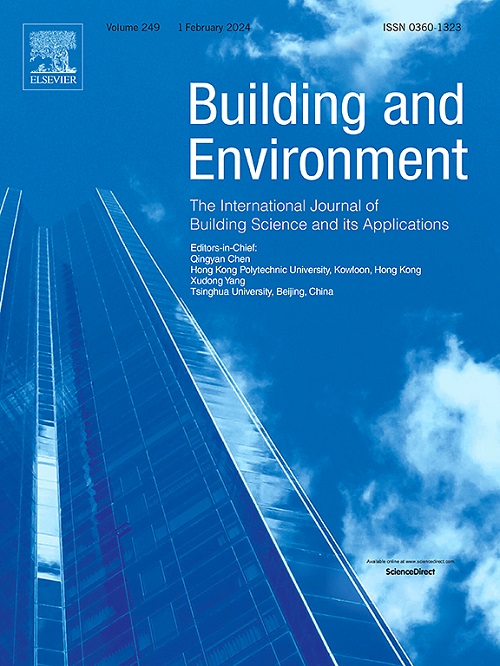Examining the physiological strain with electric fans during high indoor heat stress
IF 7.1
1区 工程技术
Q1 CONSTRUCTION & BUILDING TECHNOLOGY
引用次数: 0
Abstract
Fans have been positioned as a low-cost, sustainable, and accessible heat resilience solution during extreme heat. Many health agencies caution against fan use when air temperature exceeds skin temperature (e.g. ≥35°C) suggesting they will accelerate body heating compared to still air. However, the increased evaporative efficiency with a fan likely mitigates greater rises in core temperature and cardiovascular strain compared to still air when the air temperature is >35°C. The present study evaluated the physiological responses with and without fans when indoor air temperature exceeded skin temperature to elucidate the safe upper limit. In a randomized crossover design, 10 healthy adults (4 females, 24±4 y, 1.8±0.1 m, 75.8±10.1 kg) were exposed to a simulated indoor overheating scenario whereby air temperature increased linearly from 38°C to 47°C over 3 hours, with a fan (∼5.5 m/s) or still air (<0.2 m/s). Heart rate and core temperature were significantly greater with a fan compared to still air when air temperature was ≥44°C and ≥45°C, respectively. Mean skin temperature and skin blood flow were statistically higher with a fan. While a fan increased whole-body sweat rate, the additional sweating can be counterbalanced with increased fluid intake (∼250 mL/h at 43°C) to mitigate dehydration. In conclusion, fans result in a higher heart rate or core temperature compared to still air in healthy adults when indoor air temperature >43°C; ∼3-11°C greater than guidance from various health agencies globally. Future work in other age groups and heat-vulnerable populations is needed, including field-based evaluation.

用电风扇检测室内高热应力下的生理应变
在极端高温下,风扇被定位为一种低成本、可持续和可获得的热恢复解决方案。许多卫生机构警告说,当空气温度超过皮肤温度(例如≥35°C)时,不要使用风扇,这表明与静止空气相比,风扇会加速身体升温。然而,当空气温度为35°C时,与静止空气相比,风扇增加的蒸发效率可能会减轻核心温度和心血管压力的更大上升。本研究评估了室内空气温度超过皮肤温度时使用和不使用风扇的生理反应,以阐明安全上限。在随机交叉设计中,10名健康成年人(4名女性,24±4岁,1.8±0.1米,75.8±10.1公斤)暴露在模拟室内过热场景中,其中空气温度在3小时内从38°C线性增加到47°C,风扇(~ 5.5 m/s)或静止空气(<0.2 m/s)。当空气温度≥44°C和≥45°C时,与静止空气相比,有风扇时心率和核心温度显著增加。使用风扇时,平均皮肤温度和皮肤血流量在统计学上更高。虽然风扇增加了全身出汗率,但额外的出汗可以通过增加液体摄入量(在43°C时约250 mL/h)来抵消,以减轻脱水。综上所述,当室内空气温度为43°C时,与静止空气相比,风扇会导致健康成年人的心率或核心温度更高;比全球各卫生机构的指导高~ 3-11°C。今后需要在其他年龄组和热易感人群中开展工作,包括实地评估。
本文章由计算机程序翻译,如有差异,请以英文原文为准。
求助全文
约1分钟内获得全文
求助全文
来源期刊

Building and Environment
工程技术-工程:环境
CiteScore
12.50
自引率
23.00%
发文量
1130
审稿时长
27 days
期刊介绍:
Building and Environment, an international journal, is dedicated to publishing original research papers, comprehensive review articles, editorials, and short communications in the fields of building science, urban physics, and human interaction with the indoor and outdoor built environment. The journal emphasizes innovative technologies and knowledge verified through measurement and analysis. It covers environmental performance across various spatial scales, from cities and communities to buildings and systems, fostering collaborative, multi-disciplinary research with broader significance.
 求助内容:
求助内容: 应助结果提醒方式:
应助结果提醒方式:


